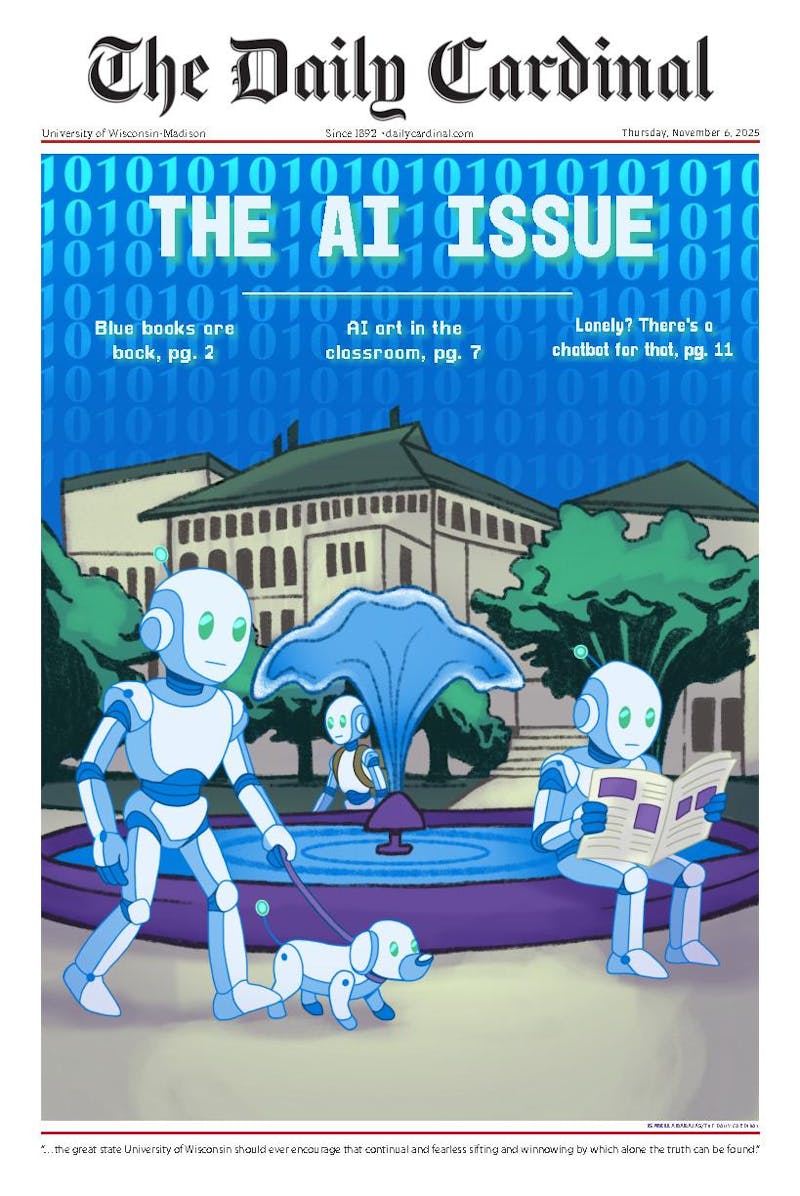\If you look around the table and you can't tell who the sucker is, it's you."" -Paul Scofield.
The raise is $3,800 in chips. All around the fraying felt of a converted pool table players draw breath with deliberate motion, as if no air should be wasted. The room suddenly seems more rigid and the observers sit up in their chairs. A dozen cigarettes secrete a fitting mist over the pool tables on a long Sunday afternoon.
Two players stare each other down, only to have some glazed paper determine where the now-$7,900 worth of chips will go. Then there's the flop. Though no faces are showing, the ace has the crowd hushed. Ellerton Warhus, a senior at Edgewood College, holds onto his cards as a bit of smile finds the edge of his mouth.
""This is what the game is about,"" he says.
The game is Texas Hold'em. Players are dealt two cards apiece, called pocket cards, which determine if a player is in. If they are out, they will fold and wait for the next round. If they're in, the first round of betting goes around the table until the dealer turns up the first three community cards, the flop. Again, players can fold based on the strength or confidence of other players' bets. Then a fourth community card, the turn card, comes up. Another betting round ensues until the final card, the river card, is revealed. The best five-card hand on the table takes the pot.
Limit Texas Hold'em, which has restrictions on the sizes of bets, is deemed a science, while no-limit, which can rob a participant of every penny, is called an art. Limit allows players regularity, while no-limit can switch the momentum of the game with a single, low spade.
All around the country, college students are flocking to the game in record numbers. Trey Alridge, general manager of Card Player Magazine said on the Web site www.pokermag.com, the number of people who play poker rose from 50 million to over 100 million in the past five years.
Anne Simaytis, the public relations coordinator at Potawatomi Casino in Milwaukee, said the poker rooms of the casino have been full ever since they opened in April.
""Poker is the game currently,"" she said.
Closer to UW-Madison, Cue-Nique, 317 W. Gorham St., hosts no-limit Texas Hold'em tournaments on Sunday and Wednesday nights. In the two months the Wednesday tournaments have been around, the average turnout brings 60 people while Sunday games have approximately half that number.
Bryan Slama, an employee at Cue-Nique noted the presence of younger players.
""Our tournaments are actually dominated by students,"" he said.
The money value of the chips is only used within the game. The actual payouts are a little more modest. The first place player would have netted $350, the second coming in at $150, the third at $100 and fourth place with $50. With a $25 buy-in, the return on the money is tempting, especially against 30 other players on a Sunday night.
The tournament got underway at four o'clock with the players gathered around three tables. By the fourth hand a player was out on each of the tables. Hands rarely exceeded two minutes. Within an hour one table is eliminated to bring more chips to one place.
Mitch Miskoski, a junior at UW-Madison, weathered the second table's competition and made it to the final showdown with eleven players. Though he was the first one out on the table, he figured he played pretty well for his rookie status.
""A friend of mine told me about it and I figured I'd try it,"" he said. ""It's pretty much what I expected.""
It used to be the desperate, the down-on-their-luck and the outlaws who took to the poker tables.
Somewhere along the way the gritty image of poker has disappeared and now gives way to bright lights and people who think of it as a career.
A game that used to be the antithesis of professionalism now has professionals in its ranks.
John Stolzman, a senior at UW-Madison, currently plays poker professionally instead of a summer job. His career options at the moment seesaw between law school and playing poker for a living.
""There's an adrenaline rush that goes with the game,"" he said.
Stolzman got into the game during his freshman year in high school when he saw the movie ""Rounders."" He was fascinated by it so much that he got a few books on poker and played on computer software to learn the odds.
When he entered his first tournament, he was ahead of a lot of players. He came in knowing when he's holding ""the nuts"" (the highest possible hand on the table) or which player is a rock (someone who takes few chances). Stolzman sees the game as a mix of chance and talent.
""There's an element of skill and an element of luck,"" he said. ""There's the variable, but then there's a lot that you can figure out.""
He said new players tend to give away what they have rather easily.
""A game is little like a puzzle,"" he said. ""Every bet, raise or call gives you another piece of the puzzle. The opponent gradually shows you what he has.""
Stolzman said he prefers high-limit games but stays away from no-limit. Given his skill, he still would have had a challenge against Warhus on Sunday.
The turn card offered a king and the river showed a seven. The opponent's pair of kings was formidable but Warhus held an ace, and, as usual, the aces took the hand. Warhus went on to win the tournament.





